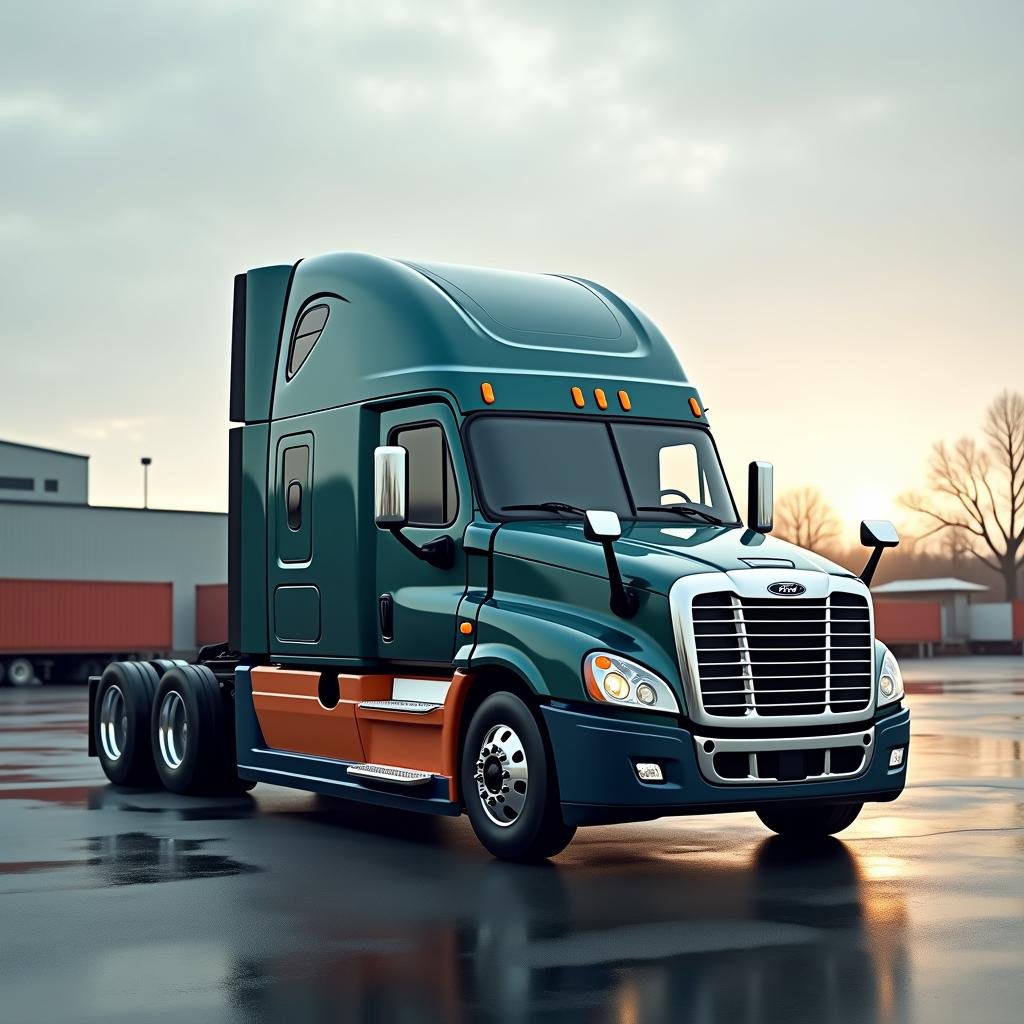In the complex world of trucking, success as an independent professional depends on far more than just driving skills. While you focus on the road, having the right insurance for owner operators serves as your critical safety net against the numerous risks that threaten your livelihood. Many operators secure basic coverage requirements but remain dangerously exposed to risks they haven’t considered – hidden gaps that could devastate their business overnight.
According to the Federal Motor Carrier Safety Administration, there were approximately 415,000 reported crashes involving large trucks in the most recent reporting year. Beyond accidents, owner-operators face unique exposures related to cargo, equipment, liability claims, and business interruptions that standard policies often leave uncovered.
This comprehensive guide will reveal five crucial but frequently overlooked insurance coverages that every owner-operator should consider. Understanding these hidden protections could make the difference between recovering from a setback and losing everything you’ve worked to build.
The Foundation of Owner-Operator Insurance Protection
Before exploring specialized coverages, it’s essential to understand the baseline insurance requirements for owner-operators. Federal regulations mandate a minimum of $750,000 in liability coverage for general freight carriers, with higher requirements for hazardous materials haulers. However, these minimums rarely provide adequate protection in today’s litigious environment.
The typical owner-operator insurance package includes:
- Primary liability coverage
- Physical damage insurance
- Bobtail/non-trucking liability
- Cargo insurance
While these form a solid foundation, they leave significant vulnerabilities that many truckers don’t discover until it’s too late. The real protection comes from understanding the specialized coverages that address the specific risks of operating as an independent trucker.
Hidden Coverage #1: Trailer Interchange Insurance
Many owner-operators mistakenly believe their physical damage policy covers any trailer they pull. The reality is far more complicated, especially when hauling trailers owned by other companies.
Why You Need This Coverage
When you operate under trailer interchange agreements – common practice in the industry – you assume liability for trailers belonging to other companies. If that trailer is damaged while in your possession, you’re financially responsible, even if your primary insurance doesn’t cover it.
Example scenario: You’re hauling a refrigerated trailer owned by a shipping company when a deer collision causes $15,000 in damage to the trailer’s cooling system. Without trailer interchange coverage, you’ll pay these repairs out-of-pocket, regardless of your physical damage policy on your tractor.
Trailer interchange insurance specifically addresses this gap, covering physical damage to non-owned trailers used under authorized interchange agreements. This specialized coverage typically includes:
- Collision damage
- Fire and theft protection
- Vandalism coverage
- Coverage for refrigeration equipment
Most policies let you select limits based on the value of trailers you typically interchange, with deductibles similar to your physical damage policy. For owner-operators regularly hauling others’ equipment, this coverage isn’t optional – it’s essential protection against a common exposure.
Hidden Coverage #2: Elevated Motor Truck Cargo Insurance
Standard cargo insurance covers damage to freight you’re hauling, but basic policies contain exclusions and limitations that create dangerous gaps in protection for trucking business owners.
Critical Cargo Coverage Enhancements
Basic cargo policies typically provide $100,000 in coverage, but this may prove woefully inadequate depending on what you haul. More concerning are the standard exclusions found in many policies:
- Temperature-controlled freight: Damage from refrigeration breakdown is often excluded unless specifically added
- Electronics and high-value goods: May have sub-limits or require additional endorsements
- Loading and unloading: Some policies only cover cargo while in transit
- Broad-form theft: Basic policies may not cover mysterious disappearance or theft by deception
Enhanced motor truck cargo insurance addresses these vulnerabilities with specialized endorsements. According to industry data from the American Trucking Association, cargo claims represent one of the most frequent loss types for owner-operators, with average claims exceeding $50,000.
Real-world impact: An owner-operator hauling pharmaceuticals worth $300,000 experienced a refrigeration failure that rendered the entire load worthless. His basic cargo policy excluded temperature-controlled freight, leaving him personally liable for the entire loss – a devastating financial blow that an enhanced cargo policy would have covered.
When evaluating cargo insurance for your operation, pay particular attention to:
- Adequate limits based on maximum load values you typically carry
- Endorsements for specific freight types (refrigerated, electronics, etc.)
- Coverage for loading/unloading operations
- Reduced or eliminated commodity exclusions
The modest premium increase for comprehensive cargo coverage provides protection against catastrophic claims that basic policies leave exposed.
Hidden Coverage #3: Rental Reimbursement with Downtime Protection
When your truck is disabled after an accident or mechanical failure, the costs extend far beyond repairs. For independent operators, time off the road means immediate lost income – a financial strain many can’t sustain for long.
The True Cost of Downtime
Standard physical damage policies cover repairs to your truck, but they don’t address the revenue loss during downtime. Consider these sobering statistics:
- The average commercial truck repair takes 4-15 days depending on damage severity
- Owner-operators typically lose $800-1,500 per day when their truck is inoperable
- Even with expedited repairs, parts delays can extend downtime by weeks
Rental reimbursement with downtime protection addresses this exposure by providing:
- Rental vehicle coverage: Reimbursement for a replacement vehicle so you can continue operations
- Lost income protection: Daily payments to offset revenue loss when no replacement is available
- Extended recovery period: Coverage that continues until your truck is repaired or replaced
This specialized coverage proves particularly valuable for owner-operator trucking businesses operating under tight margins, where even brief interruptions can threaten financial stability.
“Most owner-operators can weather repair costs covered by their physical damage policy, but few can sustain weeks without revenue,” explains insurance specialist Michael Reynolds. “Downtime protection often makes the difference between a temporary setback and a business-ending event.”
When selecting this coverage, focus on:
- Daily benefit amounts that realistically reflect your operating income
- Sufficient coverage duration (30-60 days minimum)
- Minimal waiting periods before benefits begin
For the independent operator whose livelihood depends on consistent road time, this protection isn’t merely beneficial – it’s business-critical insurance that preserves income when you need it most.
Hidden Coverage #4: Occupational Accident Insurance
As an owner-operator, you face a critical gap in protection that company drivers don’t worry about: workers’ compensation. Since you’re not an employee, traditional workers’ comp doesn’t cover you, leaving you vulnerable to medical expenses and lost income after work-related injuries.
Beyond Health Insurance
Standard health insurance policies often exclude work-related injuries, expecting these to be covered by workers’ compensation. This creates a dangerous coverage gap for owner-operators who suffer injuries on the job.
Occupational accident insurance fills this critical void with benefits including:
- Medical expense coverage for work-related injuries
- Disability income to replace lost earnings during recovery
- Accidental death and dismemberment benefits
- Coverage for injuries occurring during loading/unloading and other work activities
The trucking industry’s physical demands make this coverage particularly valuable. According to Bureau of Labor Statistics data, truck transportation has an injury rate significantly higher than the national average for all industries.
Key consideration: When comparing occupational accident policies, examine benefit limits, elimination periods, and coverage durations carefully. Policies with lower premiums often come with reduced benefits or longer waiting periods – compromises that could prove costly during recovery from a serious injury.
For owner-operators focused on trucking safety, occupational accident insurance provides essential financial protection when injuries occur despite best preventive efforts.
Hidden Coverage #5: Non-Trucking Liability Extensions
Most owner-operators understand the need for bobtail/non-trucking liability insurance that covers their truck when used for personal reasons. However, standard non-trucking liability policies contain exclusions and limitations that create dangerous coverage gaps.
Closing the Personal Use Gap
Basic non-trucking liability typically covers your truck only when it’s used for specific personal activities, not under dispatch, and without a trailer. This narrow definition creates problematic scenarios like:
- Driving to a repair shop between loads
- Personal use with an empty trailer still attached
- Running errands after dropping a load but before returning home
Enhanced non-trucking liability extensions provide broader protection with features including:
- Deadhead coverage: Protection while driving without a trailer to pick up a load
- Expanded personal use definitions: Clearer coverage for activities between dispatched loads
- Higher liability limits: Protection beyond the minimum requirements
“The gray areas between ‘under dispatch’ and ‘personal use’ create the most dangerous liability exposures for owner-operators,” notes industry expert Sarah Johnson. “Enhanced non-trucking liability clarifies these ambiguities with specific coverage extensions.”
When examining your non-trucking coverage, pay particular attention to how the policy defines “under dispatch” and what specific activities are excluded. The minimal premium difference for enhanced coverage provides significant additional protection against common claim scenarios.
Building Your Comprehensive Owner-Operator Insurance Program
The five specialized coverages discussed above address critical exposures often overlooked in standard insurance packages for independent truckers. However, effective protection requires a holistic approach tailored to your specific operation.
Strategic Coverage Evaluation
When reviewing your insurance for owner operators, consider these additional factors:
- Policy limits alignment: Ensure coverage limits reflect your actual exposure and asset values
- Deductible management: Balance premium costs against your financial ability to absorb losses
- Contractual requirements: Verify your coverage meets or exceeds carrier/shipper requirements
- Coverage coordination: Eliminate gaps between policies while avoiding costly overlaps
The most effective insurance programs integrate these specialized coverages with your core protections to create comprehensive security against the full spectrum of owner-operator risks.
Conclusion: Protecting Your Owner-Operator Investment
As an owner-operator, your truck represents more than just equipment – it’s the foundation of your business, livelihood, and future. The specialized coverages we’ve explored address critical vulnerabilities that standard insurance policies leave exposed:
- Trailer interchange insurance for non-owned equipment liability
- Enhanced cargo coverage for specialized freight and broader protection
- Rental reimbursement with downtime protection for business continuity
- Occupational accident insurance to replace workers’ compensation benefits
- Non-trucking liability extensions for comprehensive off-duty protection
While these coverages require additional premium investment, they provide protection against the most common scenarios that devastate unprepared owner-operators. The modest cost difference for comprehensive coverage pales in comparison to the potential financial impact of uncovered losses.
Your trucking operation deserves protection as specialized and hardworking as you are. Don’t wait for a claim to discover gaps in your coverage – take action today to secure your business against these hidden vulnerabilities.
Ready to review your owner-operator insurance program for dangerous gaps? Our team of transportation insurance specialists can analyze your current coverage, identify vulnerabilities, and recommend targeted solutions to protect everything you’ve built. Contact us today for a comprehensive insurance review tailored specifically for owner-operators like you.


